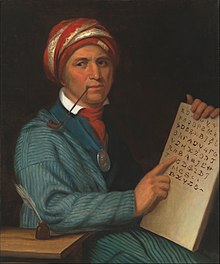 | |
| Total population | |
|---|---|
| 316,049 enrolled tribal members (Eastern Band: >13,000, Cherokee Nation: 288,749, United Keetoowah Band: 14,300)[1] 819,105 claimed Cherokee ancestry in the 2010 Census[2] | |
| Regions with significant populations | |
| United States California: large ethnic diaspora community, 22,124 registered tribal members[3] South Carolina: 3,428 [5] | |
| Languages | |
| English, Cherokee | |
| Religion | |
| Christianity, Cherokee spiritual beliefs, Animism, Kituhwa, Four Mothers Society,[7] |
The Cherokee (/ˈtʃɛrəkiː, ˌtʃɛrəˈkiː/;[8][9] Cherokee: ᎠᏂᏴᏫᏯᎢ, romanized: Aniyvwiyaʔi or Anigiduwagi, or Cherokee: ᏣᎳᎩ, romanized: Tsalagi) people are one of the Indigenous peoples of the Southeastern Woodlands of the United States. Prior to the 18th century, they were concentrated in their homelands, in towns along river valleys of what is now southwestern North Carolina, southeastern Tennessee, southwestern Virginia, edges of western South Carolina, northern Georgia and northeastern Alabama consisting of around 40,000 square miles.[10]
The Cherokee language is part of the Iroquoian language group. In the 19th century, James Mooney, an early American ethnographer, recorded one oral tradition that told of the tribe having migrated south in ancient times from the Great Lakes region, where other Iroquoian peoples have been based.[11] However, anthropologist Thomas R. Whyte, writing in 2007, dated the split among the peoples as occurring earlier. He believes that the origin of the proto-Iroquoian language was likely the Appalachian region, and the split between Northern and Southern Iroquoian languages began 4,000 years ago.[12]
By the 19th century, White American settlers had classified the Cherokee of the Southeast as one of the "Five Civilized Tribes" in the region. They were agrarian, lived in permanent villages and had begun to adopt some cultural and technological practices of the white settlers. They also developed their own writing system.
Today, three Cherokee tribes are federally recognized: the United Keetoowah Band of Cherokee Indians (UKB) in Oklahoma, the Cherokee Nation (CN) in Oklahoma, and the Eastern Band of Cherokee Indians (EBCI) in North Carolina.[13]
The Cherokee Nation has more than 300,000 tribal members, making it the largest of the 574 federally recognized tribes in the United States.[14] In addition, numerous groups claim Cherokee lineage, and some of these are state-recognized. A total of more than 819,000 people are estimated to have identified as having Cherokee ancestry on the U.S. census; most are not enrolled members of any tribe.[2]
Of the three federally recognized Cherokee tribes, the Cherokee Nation and the UKB have headquarters in Tahlequah, Oklahoma, and most of their members live in the state. The UKB are mostly descendants of "Old Settlers", also called Western Cherokee: those who migrated from the Southeast to Arkansas and Oklahoma in about 1817, prior to Indian removal. They are related to the Cherokee who were later forcibly relocated there in the 1830s under the Indian Removal Act. The Eastern Band of Cherokee Indians is located on land known as the Qualla Boundary in western North Carolina. They are mostly descendants of ancestors who had resisted or avoided relocation, remaining in the area. Because they gave up tribal membership at the time, they became state and US citizens. In the late 19th century, they reorganized as a federally recognized tribe.[15]
- ^ "Pocket Pictorial". Archived April 6, 2010, at the Wayback Machine Oklahoma Indian Affairs Commission. 2010: 6 and 37. (retrieved June 11, 2010).
- ^ a b Smithers, Gregory D. (October 1, 2015). "Why Do So Many Americans Think They Have Cherokee Blood?". www.slate.com. Retrieved April 24, 2017.
- ^ Chavez, Will (August 29, 2018). "Map shows CN citizen population for each state". Cherokee Phoenix. Tahlequah, OK. Retrieved September 4, 2020.
- ^ a b "U.S. Census website". United States Census Bureau. 2014. Retrieved April 24, 2017.
Community Facts (Georgia), 2014 American Community Survey, Demographic and Housing Estimates (Age, Sex, Race, Households and Housing, ...)
- ^ http://factfinder.census.gov/faces/nav/jsf/pages/index.xhtml Archived 2015-01-08 at the Library of Congress Web Archives, American FactFinder, Community Facts (South Carolina), 2014 American Community Survey, Demographic and Housing Estimates (Age, Sex, Race, Households and Housing,...)
- ^ "Aboriginal Population Profile, 2016 Census". www12.statcan.gc.ca/. Statistics Canada. June 21, 2018. Retrieved December 31, 2021.
- ^ Sturtevant and Fogelson, 613
- ^ Jones, Daniel (2011). Roach, Peter; Setter, Jane; Esling, John (eds.). Cambridge English Pronouncing Dictionary (18th ed.). Cambridge University Press. ISBN 978-0-521-15255-6.
- ^ Wells, John C. (2008). Longman Pronunciation Dictionary (3rd ed.). Longman. ISBN 978-1-4058-8118-0.
- ^ Stuyvesant, William C.; Fogelson, Raymond D., eds. (2004). Handbook of North American Indians: Southeast, Volume 14. Washington, DC: Smithsonian Institution. p. ix. ISBN 0-16-072300-0.
- ^ Mooney, James (2006) [1900]. Myths of the Cherokee and Sacred Formulas of the Cherokees. Kessinger Publishing. p. 393. ISBN 978-1-4286-4864-7.
- ^ Whyte, Thomas (June 2007). "Proto-Iroquoian divergence in the Late Archaic-Early Woodland period transition of the Appalachian highlands". Southeastern Archaeology. 26 (1): 134–144. JSTOR 40713422.
- ^ "Tribal Directory: Southeast". National Congress of American Indians. Retrieved June 9, 2017.
- ^ "The American Indian and Alaska Native Population: 2010" (PDF). Census 2010 Brief. February 1, 2002. Archived from the original (PDF) on January 20, 2013. Retrieved January 29, 2013.
- ^ "Cherokee Indians". Encyclopedia of North Carolina. The University of North Carolina Press. Archived from the original on December 23, 2016. Retrieved June 3, 2014.